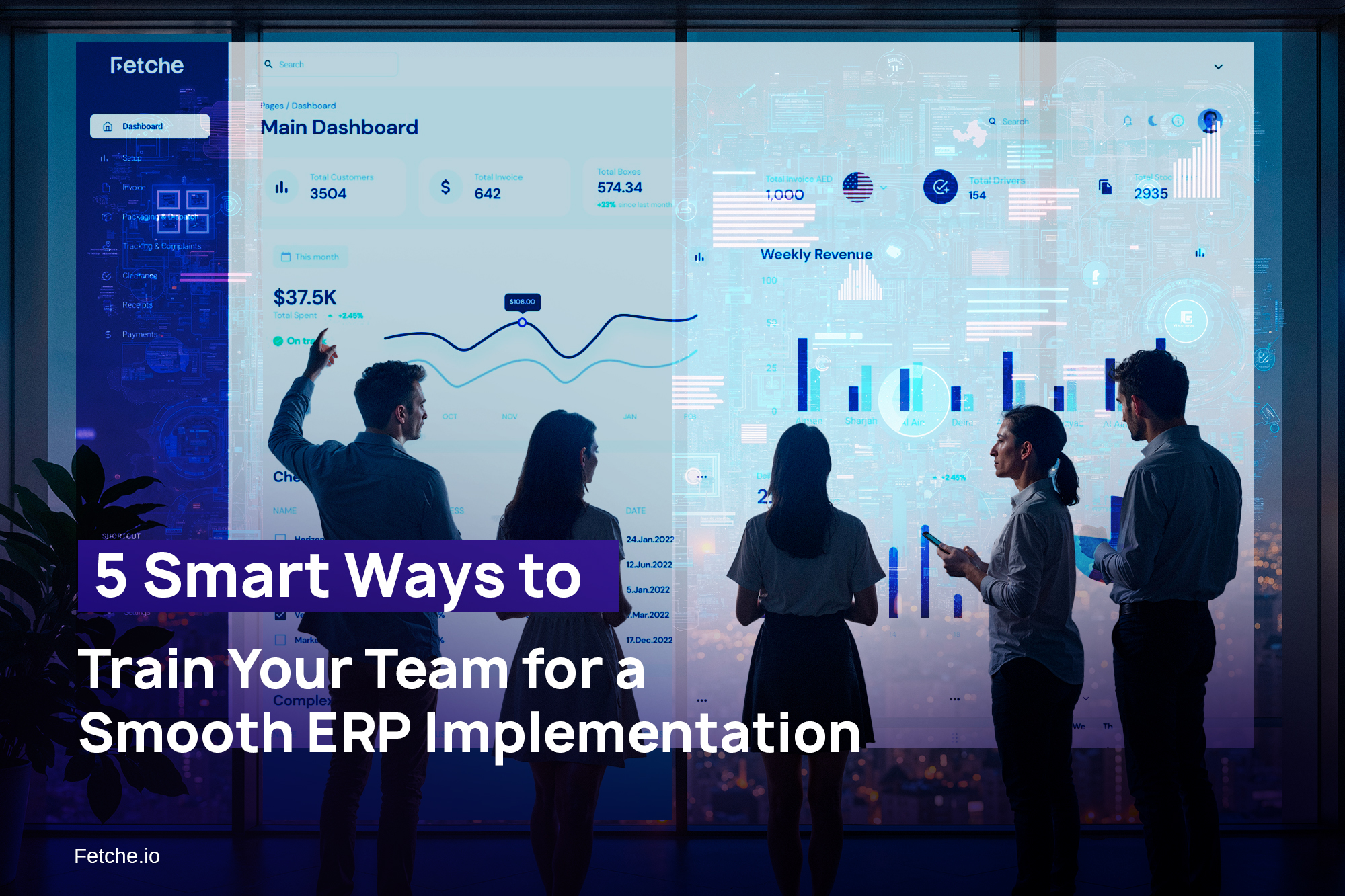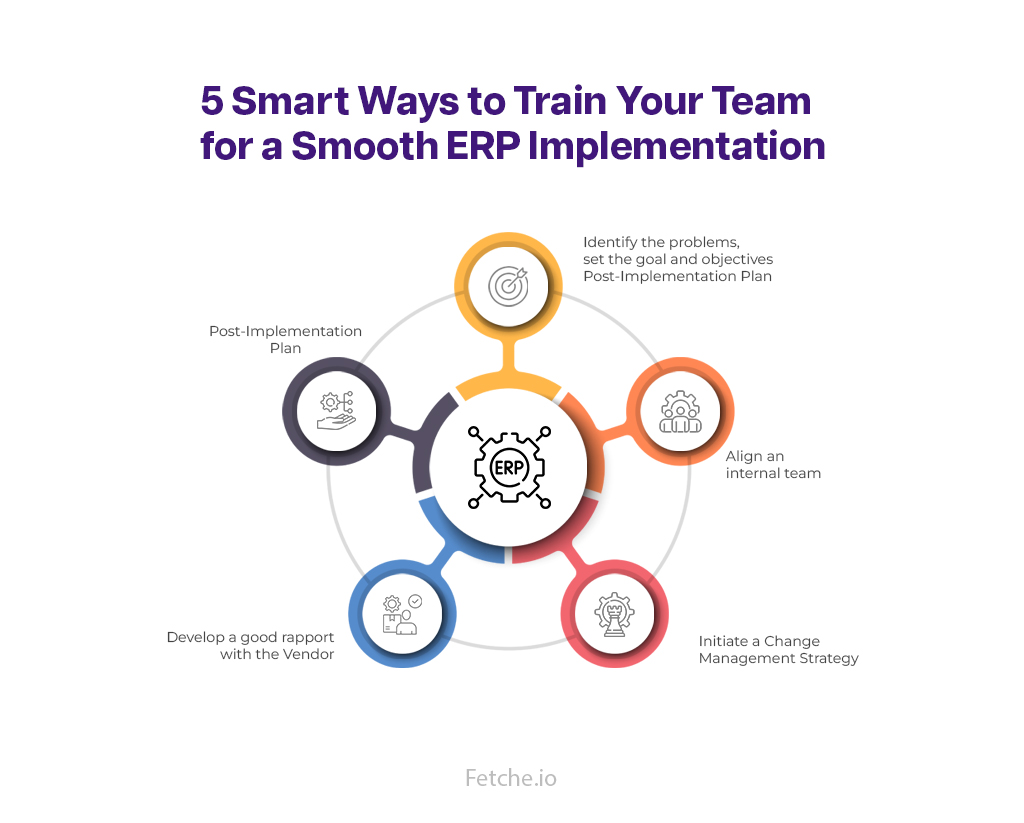
Enterprise Resource Planning (ERP) systems are not just back-office utilities anymore. They are more like a backbone of an organization or a firm—melding finance, operations, HR, supply chain, and everything in between into a single platform. Without effective ERP training, even the most advanced ERP software can fail to deliver. Poor training leads to resistance, operational delays, costly errors, and underutilized systems.
This article will provide you with a checklist of 5 smart ways to train your team for a seamless ERP implementation. If this is something that interests you, hope on!
Let’s go have a detailed discussion.
How to Overcome the Biggest ERP Training Challenges?
To get hold of the best possible training tips, companies need to be actively tackling usual training challenges even before the system goes live. Take a look at these doable strategies for preparing your employees for a successful ERP deployment.
Challenge 1: Resistance to Change
Solution: Establish Early Buy-In through Communication and Leadership Endorsement
Resistance to change is a documented fact among humans, particularly where workflows, software, and roles to which workers have become accustomed are involved. ERP systems have the tendency to redefine how one works, and this disruption can generate fear, cynicism, or even outright resistance.
In order to fight this, businesses should have a strategic ERP change management plan. Engage employees early in the decision process and be open about why the change is taking place and how it will ultimately benefit them. Assign employees who are respected by their colleagues to act as advocates. As leadership is visibly supportive of the change and workers feel heard, engagement rises and resistance falls. The aim is not to impose change but to create ownership with considerable employee engagement in ERP projects.
Challenge 2: Lack of ERP Knowledge
Solution: Create Customized Training Programs Based on User Roles
Blanket, cookie-cutter training programs do not work. ERP users have diverse jobs, and every job interacts with the system in a distinct way. A procurement officer will need immensely different knowledge than an HR manager or warehouse supervisor. That’s why the best ERP training programs are role-based. Start with a needs assessment to determine what each user group needs to know in order to be successful. Then create tailored curriculums centered on those tasks.
This style of ERP implementation training is especially important for custom ERP solutions, where generic workflows might not be relevant. Customized learning paths instill confidence, minimize user error, and enable teams to make the transition more quickly from training to real-world productivity.
Challenge 3: Scarce Training Resources
Solution: Implement Blended Learning—Mix In-Person Meetings, E-Learning, and Guides
Most organizations have limited budgets and schedules, which don’t allow for covering everything in training. The solution is to use blended learning—a combination of in-person training, online courses, video tutorials, guides, and self-paced modules through Learning Management Systems (LMS).
Blended learning has the following advantages:
- Train many teams in different locations.
- Support various learning paces and schedules.
- Workers can review content as desired.
This style is best suited to training a heterogeneous workforce with the assurance of consistency across the board. This ERP training strategy also enables users to learn in the way most suited to them.
Challenge 4: Low User Engagement
Solution: Engage Training with Interactive Use-Case Simulations
Dull, passive training is a guaranteed way to lose focus. To promote adoption, training should be interactive, meaningful, and experiential. Structure your ERP training sessions based on actual tasks. Training employees for ERP this way with simulated exercises, scenario-based problem-solving, and sandbox environments enables employees to try and fail without risk.
Add gamification features such as quizzes, points, and leaderboards to increase employee engagement in ERP projects as well as to bring vitality and healthy competition to learning. The more employees use the ERP system in real-life contexts, the more second nature it becomes by the time they go live.
Challenge 5: Measuring Training Success Proves Difficult
Solution: Establish Definite KPIs and Feedback Loops to Tune the Process
Delivering training isn’t always enough—you need to measure if it’s succeeding. ERP training incorporates quantifiable results that monitor readiness from the end user and effectiveness of training.
Set definitive KPIs such as:
- Training completion rates
- Assessment scores
- Number of support tickets after go-live
- User confidence ratings
Regular check-ins, surveys and feedback mechanisms assist you in making content, delivery, and scope adjustments. Visual dashboards can assist managers in tracking the team’s readiness for ERP implementation and knowledge deficiencies ahead of time.

Post-Go-Live Training & Support: Significance of Ongoing Training and a Helpdesk
Following an ERP implementation, most organizations tend to believe that user training is over. Nevertheless, ongoing ERP training is necessary in order to achieve sustained success and adoption by users. With updates and customizations, ERP systems change over time, and hence ongoing ERP team training enables users to keep up with new processes and functionality.
Having a dedicated help desk or support mechanism is also an essential element of any ERP change management process. It ensures immediate support for troubleshooting, enforces learning, and reduces downtime due to user mistakes or uncertainty. Through ongoing post-go-live training and easily available support, companies can get the most ROI from their ERP system and have high levels of operational effectiveness.
ERP Training Best Practices from Industry Experts
- Begin with a Strategic Training Plan: A definitive ERP implementation training plan should be in place. Start with a thorough training plan as part of the ERP onboarding process. Determine the goals for training, user roles, and major touchpoints in the ERP change management life cycle.
- Train Early, Train Often: Don’t wait for go-live. Start employee ERP training during the initial phase of implementation so that they get used to it and become more accepting of it. Reinforce the knowledge in regular sessions, rather than a single workshop.
- Use Real-World Scenarios & Hands-On Practice: Classroom-type sessions tend to be ineffective. Instead, employ actual company workflows in training so workers may witness how the system will play out in their day-to-day activity. Simulations and sandbox environments are particularly useful for instruction on “how to train staff for ERP” activity.
- Identify and Empower Super Users: Choose some important team members to become ERP champions or “super users.” They get extensive training and then assist others during implementation. This peer-learning strategy encourages employee participation in ERP projects and has a go-to person in each department, which is important for both successful ERP rollout tips and for developing easy-blending teams.
- Blend Different Learning Formats: Provide various learning styles by incorporating a combination of e-learning, video guides, live classes, user guides, and quick reference guides. This multi-channel approach enhances better retention of knowledge and makes ERP implementation more flexible at all levels of users.
- Monitor Progress & Collect Feedback: Training does not stop after deployment. Assess employee performance with testing and feedback cycles. Determine knowledge gaps and fill them as soon as possible. Ongoing improvement is essential to ERP adoption best practices and maintaining momentum far after go-live.
Final Thoughts
Effective ERP implementation relies just as much on people as it does on the platform. Lacking sound ERP user training strategies, even the most sophisticated ERP software can never unlock its full potential. By embracing intelligent, role-based training methods, combining learning styles, promoting hands-on usage, measuring readiness with well-defined KPIs, and facilitating post-go-live adoption through continuous support, companies can make ERP onboarding smoother.
